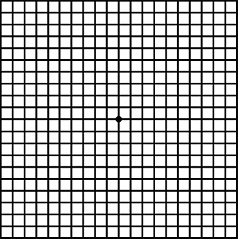General Low Vision
Low vision exists when any condition affecting the eye and visual system challenges a patient, reduces their vision, and limits their ability to perform the tasks to survive, thrive, work, and enjoy those things that bring quality and pleasure to their lives. Conditions such as macular degeneration, glaucoma, and diabetic retinopathy, result in a loss of vision that can not be enhanced through the use of conventional eyeglasses or contact lenses. An eye physician can perform surgery and prescribe medication to stabilize the condition, but improved vision may be difficult to achieve.
Low vision may present itself as: a loss of central vision, loss of peripheral or side vision, blurred vision, extreme sensitivity to light, and night blindness. Patients frequently cannot read, identify the faces of family and friends, play cards, watch TV, use a computer, drive a car, see the food on their plates or their faces in a mirror.
Amsler Grid Test

- Place the grid at eye level.
- Cover one eye.
- Center the other eye in front of the grid at a distance of approximately 16″
- Look at the dot in the center.
- Note any irregularities, distortions, missing boxes or blind spots within the grid.
- Test other eye.
NOTE: If this is the first time you have done this test, and you note any of the irregularities, distortions, missing boxes or blind spots, see your eye physician as soon as possible.
Once you are aware of the appearance of the grid, check yourself daily. If you notice any changes in its appearance, see your low vision specialist as soon as possible.


